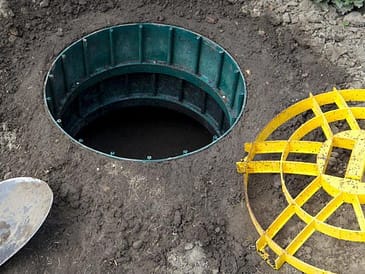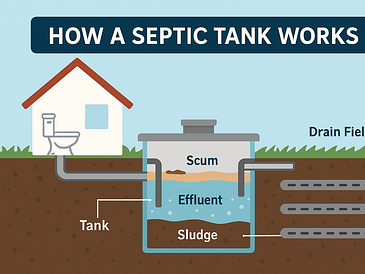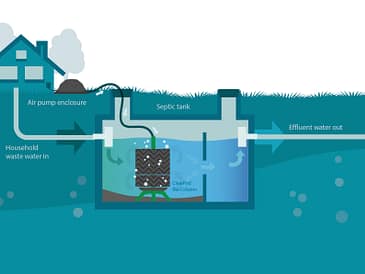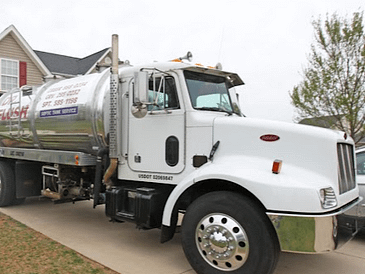Septic tanks are essential components of any household or business that relies on a private sewage system. A septic tank is a large container that collects and treats the wastewater from your sinks, toilets, showers, and other plumbing fixtures. The septic tank has two main functions: to act as a holding tank for solid waste and a treatment tank for liquid waste.
Solid waste settles at the bottom of the tank and forms a layer of sludge that needs to be pumped out periodically by a professional septic tank service. Liquid waste flows out of the tank into a drain field, where it is filtered by the soil and eventually reaches the groundwater.
Septic tanks require regular maintenance to prevent clogging, overflowing, or contamination of the environment. One of the most important aspects of septic tank maintenance is choosing the right type of septic tank for your needs. There are different types of septic tanks available, each with its own advantages and disadvantages. In this article, we will compare the pros and cons of four common types of septic tanks: concrete, plastic, fiberglass, and steel.
Concrete Septic Tanks
Concrete septic tanks are the most traditional and widely used type of septic tank. They are made of reinforced concrete and can last for decades if properly installed and maintained. Concrete septic tanks have several benefits, such as:
- Durability: Concrete septic tanks are strong and resistant to damage from external forces, such as tree roots, soil movement, or heavy vehicles12.
- Strength: Concrete septic tanks can withstand high pressure and weight, making them suitable for large households or businesses with high water usage12.
- Low cost: Concrete septic tanks are relatively inexpensive compared to other types of septic tanks, especially if they are locally manufactured and installed12.
However, concrete septic tanks also have some drawbacks, such as:
- Cracking: Concrete septic tanks can develop cracks over time due to weathering, freezing and thawing, or poor installation. Cracks can lead to leaks, which can cause environmental and health hazards123.
- Leaking: Concrete septic tanks are not watertight and can allow groundwater to seep into the tank or wastewater to seep out of the tank. This can affect the performance and efficiency of the septic system and contaminate the surrounding soil and water123.
- Corrosion: Concrete septic tanks can corrode due to the acidic nature of wastewater or the presence of sulfates in the soil. Corrosion can weaken the structure and integrity of the tank and reduce its lifespan123.
Plastic Septic Tanks
Plastic septic tanks are made of polyethylene or polypropylene, which are durable and lightweight materials. Plastic septic tanks are becoming more popular due to their ease of installation and transportation. Plastic septic tanks have several advantages, such as:
- Longevity: Plastic septic tanks are resistant to rust, cracks, and corrosion, which can extend their lifespan and reduce the need for repairs or replacements12.
- Lightness: Plastic septic tanks are much lighter than concrete septic tanks, which makes them easier to transport and install. They also require less excavation and backfilling, which can save time and money12.
- Resistance: Plastic septic tanks are immune to the effects of soil acidity, alkalinity, or salinity, which can damage other types of septic tanks. They also do not react with the chemicals or bacteria in the wastewater, which can improve the quality and safety of the effluent12.
However, plastic septic tanks also have some disadvantages, such as:
- Fragility: Plastic septic tanks are more prone to damage from external forces, such as punctures, dents, or cracks. They can also warp or deform due to temperature changes or soil pressure123.
- Instability: Plastic septic tanks are less stable than concrete septic tanks, which means they can shift or float in the ground due to water or air pressure. This can cause structural problems and leaks, which can affect the performance and safety of the septic system123.
- Environmental impact: Plastic septic tanks are not biodegradable and can pose a threat to the environment if they are not properly disposed of or recycled. They can also release harmful substances into the soil or water if they are exposed to fire or sunlight123.
Fiberglass Septic Tanks
Fiberglass septic tanks are made of glass fibers reinforced with resin, which are molded into various shapes and sizes. Fiberglass septic tanks are similar to plastic septic tanks in terms of their lightness and resistance, but they have some distinctive features that set them apart. Fiberglass septic tanks have several benefits, such as:
- Lightness: Fiberglass septic tanks are even lighter than plastic septic tanks, which makes them easier to transport and install. They also require less excavation and backfilling, which can save time and money12.
- Flexibility: Fiberglass septic tanks are more flexible than plastic septic tanks, which means they can adapt to the shape and size of the installation site. They can also be customized to fit specific needs and preferences12.
- Ease of installation: Fiberglass septic tanks are easier to install than concrete or plastic septic tanks, as they do not require heavy equipment or skilled labor. They can also be installed in any weather condition, as they are not affected by temperature or moisture12.
However, fiberglass septic tanks also have some drawbacks, such as:
- Brittleness: Fiberglass septic tanks are more brittle than plastic septic tanks, which means they can break or shatter due to impact or vibration. They can also crack due to stress or fatigue, which can cause leaks and contamination123.
- Deformation: Fiberglass septic tanks can deform due to soil pressure or water level changes, which can affect their shape and capacity. They can also expand or contract due to temperature changes, which can cause cracks or leaks123.
- High cost: Fiberglass septic tanks are more expensive than concrete or plastic septic tanks, especially if they are custom-made or imported. They can also incur higher installation and maintenance costs due to their fragility and complexity123.
Steel Septic Tanks
Steel septic tanks are made of galvanized or stainless steel, which are strong and sturdy materials. Steel septic tanks are less common than other types of septic tanks, but they have some unique advantages and disadvantages that make them suitable for certain situations. Steel septic tanks have several benefits, such as:
- Strength: Steel septic tanks are stronger and more stable than concrete, plastic, or fiberglass septic tanks, which makes them ideal for high-pressure or high-traffic applications. They can also withstand harsh weather conditions and natural disasters12.
- Stability: Steel septic tanks are more stable than plastic or fiberglass septic tanks, which means they do not shift or float in the ground due to water or air pressure. They also do not warp or deform due to temperature or soil changes12.
- Availability: Steel septic tanks are more readily available than plastic or fiberglass septic tanks, as they are manufactured and distributed by many companies and suppliers. They can also be easily found and replaced in case of damage or malfunction12.
However, steel septic tanks also have some disadvantages, such as:
- Rust: Steel septic tanks are susceptible to rust and corrosion, which can reduce their lifespan and performance. Rust can also contaminate the wastewater and the surrounding soil and water, which can pose health and environmental risks123.
- Corrosion: Steel septic tanks can corrode due to the acidic nature of wastewater or the presence of sulfates in the soil. Corrosion can weaken the structure and integrity of the tank and cause leaks or failures123.
- Short lifespan: Steel septic tanks have a shorter lifespan than concrete, plastic, or fiberglass septic tanks, as they deteriorate faster due to rust and corrosion. They typically last for 15 to 20 years, compared to 40 to 50 years for other types of septic tanks123.
Conclusion
Choosing the right type of septic tank for your needs is a crucial decision that can affect the performance, efficiency, and safety of your septic system. There are different types of septic tanks available, each with its own pros and cons. Concrete septic tanks are durable, strong, and low-cost, but they can crack, leak, and corrode. Plastic septic tanks are long-lasting, light, and resistant, but they can be fragile, unstable, and environmentally harmful. Fiberglass septic tanks are light, flexible, and easy to install, but they can be brittle, deformed, and high-cost. Steel septic tanks are strong, stable, and available,





